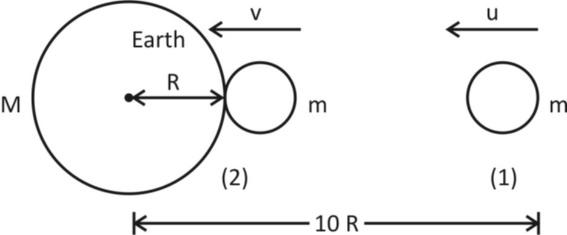
An asteroid is moving directly towards the centre of the earth. When at a distance of $10$R (R is the radius of the earth) from the earth centre, it has a speed of $12$km/s. Neglecting the effect on the earth's atmosphere, what will be the speed of the asteroid when it hits the surface of the earth (escape velocity from the earth is $11.2$km/s)? Give your answer to the nearest integer in Kilometre/s_ _ _ _ _ _
Answer
521.1k+ views
Hint: As the asteroid is moving towards earth, then by conservation by mechanical energy, the total energy at a distance $10R$ from the centre of earth will be the same as the total energy at distance R from the centre of earth.
Formula used:
1. Initial Mechanical Energy $ = $ Final Mechanical Energy
2. $K.E = \dfrac{1}{2}m{v^2}$
3. Potential Energy $ = \dfrac{{ - GMm}}{R}$
Complete step by step answer:
Let the velocity of asteroid at distance $10R$ from centre of Earth by, $u = 12km/s$ and the final velocity of asteroid at a distance R from the centre of earth be v km/s as shown in figure below:

Now, initial Mechanical Energy $ = $ Initial kinetic energy $ + $ initial potential energy
$ = \dfrac{1}{2}m{u^2} + \left( {\dfrac{{ - GMm}}{{10R}}} \right)$
And Final Mechanical energy $ = $ Final kinetic energy $ + $ initial potential energy
$ = \dfrac{1}{2}m{u^2} + \left( {\dfrac{{ - GMm}}{{10R}}} \right)$
Where M is mass of Earth
m is mass of asteroid
R is radius of earth and
G is universal Gravitational constant
So, by conservation of mechanical energy, initial mechanical energy $ = $ final mechanical energy
$ \Rightarrow \dfrac{1}{2}m{u^2} + \left( {\dfrac{{ - GMm}}{{10R}}} \right) = \dfrac{1}{2}m{v^2} + \left( {\dfrac{{ - GMm}}{R}} \right)$
$ \Rightarrow \dfrac{1}{2}m{v^2} - \dfrac{1}{2}m{u^2} = \dfrac{{ - GMm}}{{10R}} + \dfrac{{ - GMm}}{R}$
$ \Rightarrow \dfrac{1}{2}\left( {{v^2} - {u^2}} \right) = \dfrac{{ - GMm}}{R}\left( {\dfrac{1}{{10}} - 1} \right)$
$ \Rightarrow \dfrac{1}{2}\left( {{v^2} - {u^2}} \right) = \dfrac{{ - GM}}{R} \times \dfrac{{ - 9}}{{10}}$
$ \Rightarrow {v^2} - {u^2} = \dfrac{{9GM}}{{10R}} \times 2$
$ \Rightarrow {v^2} = {u^2} + \dfrac{{9GM}}{{5R}}........\left( 1 \right)$
Now, here $u = 12km/s = 12000m/s$
M$ = $ mass of earth
As $\dfrac{{GM}}{{{R^2}}} = g \Rightarrow \dfrac{{GM}}{R} = gR$
So, \[{v^2} = {u^2} + \dfrac{9}{5}gR\]
\[\Rightarrow {v^2} = {\left( {12000} \right)^2} + \dfrac{9}{5} \times 9.8 \times 6400000\]
\[\Rightarrow {v^2} = 14000000 + 112896000\]
\[\Rightarrow {v^2} = 256,896,000\]
\[\Rightarrow v = 16,027.97m/s\]
$\Rightarrow v \simeq 16km/s$
Note:
The relation between acceleration due to gravity, g and universal gravitational constant, G is
$g = \dfrac{{GM}}{{{R^2}}} \Rightarrow \dfrac{{GM}}{R} = gR$
So, we have replaced $\dfrac{{GM}}{R}$ with gR in equation ....(1).
Formula used:
1. Initial Mechanical Energy $ = $ Final Mechanical Energy
2. $K.E = \dfrac{1}{2}m{v^2}$
3. Potential Energy $ = \dfrac{{ - GMm}}{R}$
Complete step by step answer:
Let the velocity of asteroid at distance $10R$ from centre of Earth by, $u = 12km/s$ and the final velocity of asteroid at a distance R from the centre of earth be v km/s as shown in figure below:

Now, initial Mechanical Energy $ = $ Initial kinetic energy $ + $ initial potential energy
$ = \dfrac{1}{2}m{u^2} + \left( {\dfrac{{ - GMm}}{{10R}}} \right)$
And Final Mechanical energy $ = $ Final kinetic energy $ + $ initial potential energy
$ = \dfrac{1}{2}m{u^2} + \left( {\dfrac{{ - GMm}}{{10R}}} \right)$
Where M is mass of Earth
m is mass of asteroid
R is radius of earth and
G is universal Gravitational constant
So, by conservation of mechanical energy, initial mechanical energy $ = $ final mechanical energy
$ \Rightarrow \dfrac{1}{2}m{u^2} + \left( {\dfrac{{ - GMm}}{{10R}}} \right) = \dfrac{1}{2}m{v^2} + \left( {\dfrac{{ - GMm}}{R}} \right)$
$ \Rightarrow \dfrac{1}{2}m{v^2} - \dfrac{1}{2}m{u^2} = \dfrac{{ - GMm}}{{10R}} + \dfrac{{ - GMm}}{R}$
$ \Rightarrow \dfrac{1}{2}\left( {{v^2} - {u^2}} \right) = \dfrac{{ - GMm}}{R}\left( {\dfrac{1}{{10}} - 1} \right)$
$ \Rightarrow \dfrac{1}{2}\left( {{v^2} - {u^2}} \right) = \dfrac{{ - GM}}{R} \times \dfrac{{ - 9}}{{10}}$
$ \Rightarrow {v^2} - {u^2} = \dfrac{{9GM}}{{10R}} \times 2$
$ \Rightarrow {v^2} = {u^2} + \dfrac{{9GM}}{{5R}}........\left( 1 \right)$
Now, here $u = 12km/s = 12000m/s$
M$ = $ mass of earth
As $\dfrac{{GM}}{{{R^2}}} = g \Rightarrow \dfrac{{GM}}{R} = gR$
So, \[{v^2} = {u^2} + \dfrac{9}{5}gR\]
\[\Rightarrow {v^2} = {\left( {12000} \right)^2} + \dfrac{9}{5} \times 9.8 \times 6400000\]
\[\Rightarrow {v^2} = 14000000 + 112896000\]
\[\Rightarrow {v^2} = 256,896,000\]
\[\Rightarrow v = 16,027.97m/s\]
$\Rightarrow v \simeq 16km/s$
Note:
The relation between acceleration due to gravity, g and universal gravitational constant, G is
$g = \dfrac{{GM}}{{{R^2}}} \Rightarrow \dfrac{{GM}}{R} = gR$
So, we have replaced $\dfrac{{GM}}{R}$ with gR in equation ....(1).
Recently Updated Pages
Physics and Measurement Mock Test 2025 – Practice Questions & Answers

NCERT Solutions For Class 5 English Marigold - The Little Bully

NCERT Solutions For Class 12 Maths Three Dimensional Geometry Exercise 11.1

NCERT Solutions For Class 11 English Woven Words (Poem) - Ajamil And The Tigers

NCERT Solutions For Class 6 Hindi Durva - Bhaaloo

NCERT Solutions For Class 12 Physics In Hindi - Wave Optics

Trending doubts
1 Quintal is equal to a 110 kg b 10 kg c 100kg d 1000 class 11 physics CBSE

Explain zero factorial class 11 maths CBSE

The process in which gas transform into solid is called class 11 chemistry CBSE

How does Amoeba obtain its food a Endocytosis b Exocytosis class 11 biology ICSE

The string of a kite is 50m long and it makes an angle class 11 maths CBSE

A solution of a substance X is used for white washing class 11 chemistry CBSE




